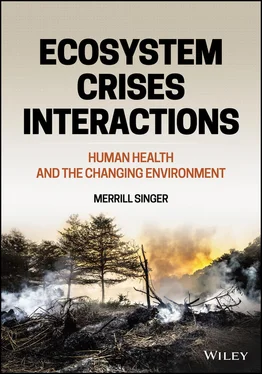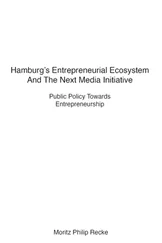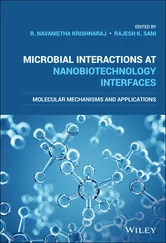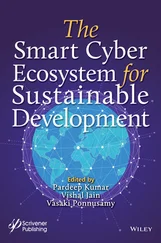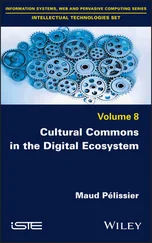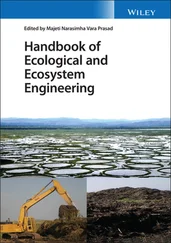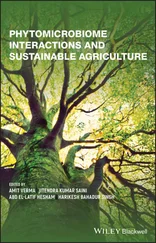2.3.2.3 The Convention on Biological Diversity
This discussion draws attention to the incredible diversity of life in modern ecology. Biodiversity is formally defined in the Convention on Biological Diversity as “the variability among living organisms from all sources including, inter alia, terrestrial, marine and other aquatic ecosystems and the ecological complexities of which they are part; this includes diversity within species, between species and of ecosystems” (Reid et al . 1993). The Convention is a treaty signed by 168 government leaders at the United Nations Conference on Environment and Development on June 5, 1992, a historic meeting known as the Rio Earth Summit. It asserts that biological diversity is about more than plants, animals, fungi, and microorganisms, the variability within and across species, the communities organisms form, and habitats and ecosystems. Additionally, and importantly, it is about the human need for food, water, clean air, medicines, shelter, and a healthy environment ( Table 2.1). According to the Convention, “[b]iodiversity provides a large number of goods and services that sustain our lives” (Convention on Biological Diversity 2018).
Inherently, biodiversity is multidimensional, encompassing many aspects of the variability of life on Earth, including the taxonomic classification of species, impacts of species on one another and on the abiotic environment, the evolutionary relatedness of species, the genetic make‐up of organisms, and landscape characteristics.
Table 2.1 Diverse benefits from nature.
Source: Modified from World Wildlife Fund, Living Planet Report 2018. Retrieved from: https://www.worldwildlife.org/pages/living‐planet‐report‐2018.
| Cultural resourcesEmotional and physical healthRecreationEsthetic valuesSpiritual values |
| ProvisionsFoodWaterMedicinal resourcesOxygenMaterial resources |
| ProcessesNutrient cyclingPhotosynthesisSoil formation |
| RegulationsAir qualityClimate and extreme eventsWaterErosionPollination |
Despite their importance to ecological health, there remain significant gaps in available biodiversity data. The kinds of knowledge that are limited include the time depth of information about particular habitats, the actual composition of species in an ecosystem, the number of individuals within local populations of organisms, and changes in the areal range in which species are found.
Biodiversity “is changing across the world and this change is mostly negative” (Turak et al . 2017) from the standpoint of health across species (Butchart et al . 2010), a pattern known as bioadversity. A growing body of research, for example, indicates that among many species there are shifting habitat ranges, seasonal activities, life cycle events (e.g., the time of emergence of leaves and flowers or the arrival dates of migratory birds), predator–prey interactions, and migratory patterns (Forcada & Hoffman 2014; Zhang et al . 2014). Change in these and other features is not new. Since they appeared on the planet, plants and animals have reacted to environmental changes by adapting in various ways (e.g., changing color, body shape, behavior), migrating to new areas with different conditions, or, if unable to adapt successfully, going extinct. Which of these possibilities lie ahead for the current inhabitants of Earth, including ourselves? According to Nogués‐Bravo et al . (2018), “How individual species and entire ecosystems will respond to future climate change are among the most pressing questions facing ecologists.” But the issue is not just climate change—the same applies to species and entire ecosystem responses to other adverse anthropogenic environmental modifications.
With regard to human health, maintaining biodiversity is of vital importance. Human medicines often are first discovered in wild‐dwelling species. So too are various pathogens and disease vectors, which can only be brought under control by studying their behaviors and habitats. As Chivian (1997, p. 8) maintains:
The study of species and biodiversity may be the best means we have for recognizing future dangers to human health from global environmental degradation … [W]e must focus much greater attention on biodiversity loss, which looms as a slowly evolving, potential medical emergency of unprecedented proportions, still largely unappreciated by policymakers and the public.
A species of considerable interest with regard to medicine development is the great white shark ( Carcharodon carcharias ), an animal that usually is far more terrifying in our imaginations than it is in reality. Found as a top predator in the coastal surface waters of all the major oceans, great whites face multiple anthropogenic challenges (e.g., accidental deaths on fishing longlines, poaching for the shark fin soup market, sport fishing for shark jaw trophies, ocean pollution). The scale of these threats has led the IUCN to list them as a vulnerable species and the Convention on International Trade in Endangered Species of Wild Fauna and Flora (CITES) as an Appendix II species (i.e., a species for which trade must be controlled in order to avoid human utilization that is incompatible with its survival). Medical interest in great whites stems from the fact that they are known to be super‐healers. During their long evolutionary history, they have developed a genetic tool‐kit that enhances several key processes involved in wound healing. These include sequences of DNA that code for rapid damage response, including amplified blood‐clotting agents and scaffolding proteins that serve as the foundation for new tissue. Not only do great whites have uniquely adapted versions of these genes, but it appears that they have them in greater supply than other species, including us. Moreover, in theory, sharks and other large‐bodied, long‐lived animals with many more body cells than humans should have a greater chance of developing oncogenic mutations. Great whites, however, do not have a higher incidence of cancer than humans, and this may be because of clusters of genes that protect the integrity of their genetic code itself, a trait known in biology as genome stability. “Understanding how these genes might be inoculating these animals from cancer could be a huge benefit to humans,” according to Michael Stanhope (quoted in Molenti 2019), an evolutionary biologist at Cornell University who co‐led a project to map the great white genome (Marra et al . 2019).
Because “global biological diversity is declining in the face of numerous pressures” (Wetzel et al . 2017, p. 78), and this loss has grave implications, since the early 1970s biodiversity has emerged as a critical and heated scientific and political issue. In the case of sharks, their potential relevance to human health goes beyond the issue of cancer and includes their ability to heal quickly from wounds and resist infections. By sequencing the sharks’ genome, researchers are trying to identify which genes contribute to these abilities and translate this finding into advances in wound‐healing human medicines. Already, a skin‐graft device called the Integra Omnigraft Dermal Regeneration Matrix (Omnigraft) has been approved by the U.S. Food and Drug Administration (FDA 2016). This material, which uses a combination of silicone, cow collagen, and shark cartilage, is used to help heal certain life‐threatening burns and diabetic foot ulcers. The medical potential of the shark genome also extends to a possible new way of treating pulmonary fibrosis, a lung disease that occurs when tissue becomes damaged and scarred, making it difficult for the lungs to work properly and causing progressive shortness of breath. A new drug called AD‐114, which mimics shark antibodies, is being developing in Australia. It belongs to a class of therapies called i‐bodies, which are proteins that combine the features of small molecules and antibodies. In animal testing, AD‐114 has been found to only bind with scarred lung cells while ignoring healthy lung tissue (Pulmonary Fibrosis News 2016).
Читать дальше
